Influence of Various Heat Treatments on Hardness and Impact Strength of Uddeholm Balder: Cr-Mo-V-Ni Novel Steel Used for Engine Construction
Abstract
:1. Introduction
2. Materials and Methods
2.1. Hardness Measurement
2.2. Impact Toughness Test
2.3. Heat Treatments
3. Results
4. Discussion
5. Conclusions
- (1)
- Occurrence of temper embrittlement was confirmed, and possible explanations were proposed. Authors suspect it originated in a cooling rate lower than critical, and additionally, non-negligible content of Phosphorus segregating to the grain boundary contributed to that phenomenon. Thus, to avoid it, either purifying an alloy or more thought-through heat treatment should be considered.
- (2)
- Tests conducted after heat treatment of samples show substantial improvement in mechanical properties of the examined alloy. Mainly, an increase in hardness from 46.4 HRC to 48.4 HRC with impact toughness simultaneously rising three-fold (from 17 J to 57.3 J) was recorded, and a six-fold increase of impact toughness (from 17 J to 135.4 J) was possible with a hardness drop from 46.4 HRC to 33.5 HRC. It proves that striking a satisfying balance between those two properties is indeed possible.
- (3)
- Ductile-brittle transition was not detected in temperatures as low as −29 °C, making alloy in question a promising material for use in engine applications.
- (4)
- Secondary hardening was not observed; as-delivered material decreased in hardness when tempered.
Author Contributions
Funding
Institutional Review Board Statement
Informed Consent Statement
Data Availability Statement
Acknowledgments
Conflicts of Interest
References
- Simcoe, C.R. Metallurgy Lane: The History of Alloy Steels pt. 2; Advanced Materials & Processes: Metals Park, OH, USA, 2014. [Google Scholar]
- Simcoe, C.R. Metallurgy Lane: The History of Alloy Steels pt. 1; Advanced Materials & Processes: Metals Park, OH, USA, 2014. [Google Scholar]
- Pirault, J.-P.; Flint, M. Opposed Piston Engines: Evolution, Use and Future Applications; SAE International: Warrendale, PA, USA, 2010. [Google Scholar]
- Przybyłowicz, K. Metaloznawstwo, 4th ed.; Wydawnictwa Naukowo-Techniczne: Warszawa, Poland, 1994; p. 327. [Google Scholar]
- Nordwood, C.G. The Effect of Nickel Content on the Mechanical Properties and Microstructure of a High Toughness Secondary Hardening Steel, Thesis for the Degree of Doctor of Philosophy; Carnegie Mellon University: Pittsburgh, PA, USA, 2016. [Google Scholar]
- Hitit, A. Precipitation Reactions in a Martensitic Precipitation-Strengthened Stainless Steel and the Effects of Nickel and Silicon on Precipitation Reactions and Toughness, Thesis for the Degree of Doctor of Philosophy; Carnegie Mellon University: Pittsburgh, PA, USA, 2002. [Google Scholar]
- Motley, M. The Role of Molybdenum in Reducing Temper Embrittlement in Steels, Thesis for the Degree of Doctor of Philosophy; Sheffield Hallam University: Sheffield City, UK, 1984. [Google Scholar]
- McMahon, C.J.; Cianelli, A.K.; Feng, H.C. The influence of Mo on P-lnduced temper embrittlement in Ni-Cr steel. Met. Mater Trans A 1977, 8, 1055–1057. [Google Scholar] [CrossRef]
- Wang, Z.; Hui, W.; Chen, Z.; Zhang, Y.; Zhao, X. Effect of vanadium on microstructure and mechanical properties of bainitic forging steel. Mater. Sci. Eng. A 2020, 771, 138653. [Google Scholar] [CrossRef]
- Bain, E.C.; Paxton, H.W. Alloying Elements in Steel, 2nd ed.; ASM: Metals Park, OH, USA, 1966. [Google Scholar]
- De Souza Bott, I. The Role of Microstructure in the Temper Embrittlement of Low Alloy Steels, Thesis for the Degree of Doctor of Philosophy; Sheffield Hallam University: Sheffield City, UK, 1987. [Google Scholar]
- Beech, S.M. Property Relationships in Low Alloy Ni-Cr-Mo-V Steels Manufactured by Different Production Routes, Thesis for the Degree of Doctor of Philosophy; Joint University of Manchester/UMIST: Manchester, UK, 1985. [Google Scholar]
- Jolivet, H.; Vidal, G. Valeur de l’essai de résilience pour l’étude de la fragilité de revenue. La Rev. Métallurgie 1944, 41, 378–388. [Google Scholar] [CrossRef]
- Samant, S.; Singh, I.V.; Singh, R.N. Effect of Thermo-mechanical Treatment on High Temperature Tensile Properties and Ductile–Brittle Transition Behavior of Modified 9Cr-1Mo Steel. Met. Mater Trans. 2020, 51, 3869–3885. [Google Scholar] [CrossRef]
- Chatterjee, A.; Chakrabarti, D.; Moitra, A.; Mitra, R.; Bhaduri, A.K. Effect of normalization temperatures on ductile–brittle transition temperature of a modified 9Cr–1Mo steel. Mater. Sci. Eng. A 2014, 618, 219–231. [Google Scholar] [CrossRef]
- Lu, Z.; Faulkner, R.G.; Flewitt, P.E.J. The role of irradiation-induced phosphorus segregation in the ductile-to-brittle transition temperature in ferritic steels. Mater. Sci. Eng. A 2006, 437, 306–312. [Google Scholar] [CrossRef]
- Ding, H.L.; Zhang, T.; Fang, Q.F.; Gao, R.; Wang, X.P.; Liu, C.S. Nondestructive Evaluation of Ductile to Brittle Transition Temperature for Martensitic Steels Based on Magnetic Measurements. J. Nondestruct. Eval. 2017, 36, 28. [Google Scholar] [CrossRef]
- Wu, C.; Han, S. Microstructural Evolution and Mechanical Properties of a Low Alloy High Strength Ni-Cr-Mo-V steel During Heat Treatment Process. In Proceedings of the International Conference on Computer Information and Automation Engineering, IOP Conference Series: Materials Science and Engineering, Yichang, China, 17–19 November 2017. [Google Scholar]
- Uddeholm Balder Brochure. Available online: https://www.uddeholm.com/files/PB_balder_english.pdf (accessed on 27 January 2021).
- Chandler, H. Hot Work Tool Steels (H series) in Heat Treater’s Guide—Practices and Procedures for Irons and Steels, 2nd ed.; ASM International: Metals Park, OH, USA, 1995; pp. 600–605. [Google Scholar]
- Davis, J.R. Metals Handbook Desk Edition, 2nd ed.; ASM International: Metals Park, OH, USA, 1998. [Google Scholar]
- Collective work, Metaloznawstwo. Wiadomości Ogólne in Mały Poradnik Mechanika, Tom I.; Kosieradzki, P., Ed.; Wydawnictwa Naukowo-Techniczne: Warszawa, Poland, 1994. [Google Scholar]
- Uddeholm Orvar Supreme Arochure. Available online: https://www.uddeholm.com/app/uploads/sites/10/2017/05/orvar_supreme-eng_R1309_e8-1.pdf (accessed on 8 February 2021).
- Białecki, M.; Charakterystyki, S. Stale Narzędziowe, Seria F, Tom III—Stale Stopowe do Pracy na Gorąco; Wydawnictwo Śląsk: Katowice, Poland, 1979. [Google Scholar]
- Chełmińska, H.; Przegaliński, S.; Bernacik, A. Charakterystyki stali. Stale Konstrukcyjne Stopowe, Seria C tom I Część 3—Stale do Ulepszania Cieplnego; Przegaliński, S., Ed.; Wydawnictwo Śląsk: Katowice, Poland, 1984. [Google Scholar]
- Uddeholm Dievar Brochure. Available online: https://www.uddeholm.com/app/uploads/sites/41/2017/09/Tech-Uddeholm-Dievar-EN.pdf.pdf (accessed on 22 February 2021).
- Uddeholm QRO 90 Supreme Brochure. Available online: https://www.uddeholm.com/files/PB_qro_90_supreme_english.pdf (accessed on 22 February 2021).
- Uddeholm Vidar Superior Brochure. Available online: https://www.uddeholm.com/files/PB_Uddeholm_vidar_superior_english.pdf (accessed on 22 February 2021).
- Bohler W300 Brochure. Available online: https://www.bohler.pl/app/uploads/sites/92/2020/12/productdb/api/w300de.pdf (accessed on 22 February 2021).
- Bohler W400 Brochure. Available online: https://www.bohler.pl/app/uploads/sites/92/2020/12/productdb/api/w400de.pdf (accessed on 22 February 2021).
- Uddeholm Pocketbook. Available online: https://www.uddeholm.com/app/uploads/sites/41/2017/12/Tech-Uddeholm-Pocket-Book-1804.pdf (accessed on 27 January 2021).
- Opaliński, M.; Mazuro, P.; Rostek, E. Impact resistance tests of steel alloys after different heat and surface treatments. Metals 2021, 11, 505. [Google Scholar]
- Guillou, R.; Guttmann, M.; Dumoulin, P. Role of molybdenum in phosphorus-induced temper embrittlement of 12%Cr martensitic stainless steel. Met. Sci. 1981, 15, 63–72. [Google Scholar] [CrossRef]
- PN-EN ISO 6507-1:1999. Metals—Vickers Hardness Measurement—Part 1: Test Method; Polish Committee for Standardization: Warszawa, Poland, 2018; Available online: https://sklep.pkn.pl/pn-en-iso-6507-1-2018-05e.html (accessed on 30 August 2021).
- PN-EN ISO 148-1:2017-02. Metals—Charpy Impact Test—Part 2: Testing of Pendulum Hammers; Polish Committee for Standardization: Warszawa, Poland, 2017; Available online: https://sklep.pkn.pl/pn-en-iso-148-2-2017-02e.html (accessed on 30 August 2021).
- Zhang, S.-H.; Fan, Y.-Z.; Chen, Y.-M.; Zhou, S.-L. A new nondestructive test technique for predicting the temper embrittlement of turbine rotor steel with genetic programming. In Proceedings of the IEEE International Conference on Industrial Technology (ICIT ‘05), Hong Kong, China, 14–17 December 2005; pp. 768–771. [Google Scholar]
- Kameda, J.; Ranjan, R. Nondestructive evaluation of steels using acoustic and magnetic barkhausen signals-I. Effect of carbide precipitation and hardness. Acta Metall. 1987, 35, 1515–1526. [Google Scholar] [CrossRef]
- Kameda, J.; Ranjan, R. Nondestructive evaluation of steels using acoustic and magnetic barkhausen signals-II. Effect of intergranular impurity segregation. Acta Metall. 1987, 35, 1527–1531. [Google Scholar] [CrossRef]
- Bhadeshiab, H.K.D.H.; Suhb, D. Is a low-phosphorus content in steel a productrequirement? Ironmak. Steelmak. 2015, 42, 259–267. [Google Scholar] [CrossRef]
- Dumoulin, P.; Guttmann, M.; Foucault, M.; Palmier, M.; Wayman, C.M.; Biscondi, M. Role of molybdenum in phosphorus-induced temper embrittlement. Met. Sci. 1980, 14, 1–15. [Google Scholar] [CrossRef]
- Grabke, H.J.; Hennesen, K.; Moller, R.; Wei, W. Effects of manganese on the grain boundary segregation, bulk and grain boundary diffusivity of P in ferrite. Scr. Metall. 1987, 21, 1329–1334. [Google Scholar] [CrossRef]
- Krauss, G.; McMahon, C.J., Jr. Low toughness and embrittlement phenomena in steels. In Steels: Processing, Structure and Performance; Olson, G.B., Owen, W.S., Eds.; ASM International: Metals Park, OH, USA, 1992; pp. 295–322. [Google Scholar]
- Wallin, K. Fracture Toughness of Engineering Materials—Estimation and Application; FESI Publishing: Warrington, UK, 2011. [Google Scholar]
- Pavlina, E.J.; van Tyne, C.J. Correlation of Yield Strength and Tensile Strength with Hardness for Steels. J. Mater. Eng. Perform. 2008, 17, 888–893. [Google Scholar] [CrossRef]
- Muszka, K.; Majta, J.; Bienias, Ł. Effect of grain refinement on mechanical properties of microalloyed steel. Metall. Foundry Eng. 2006, 32, 87–96. [Google Scholar] [CrossRef] [Green Version]

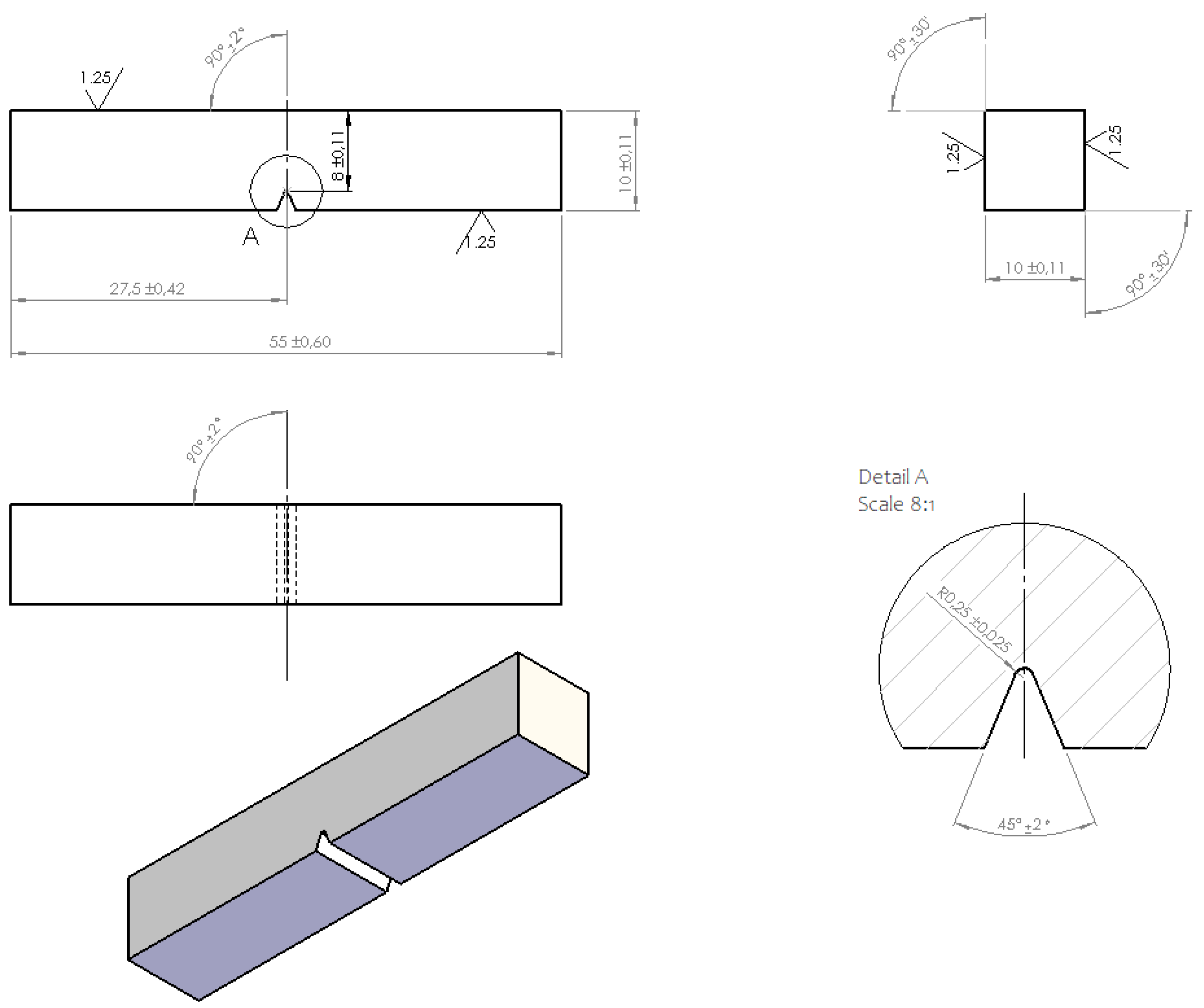
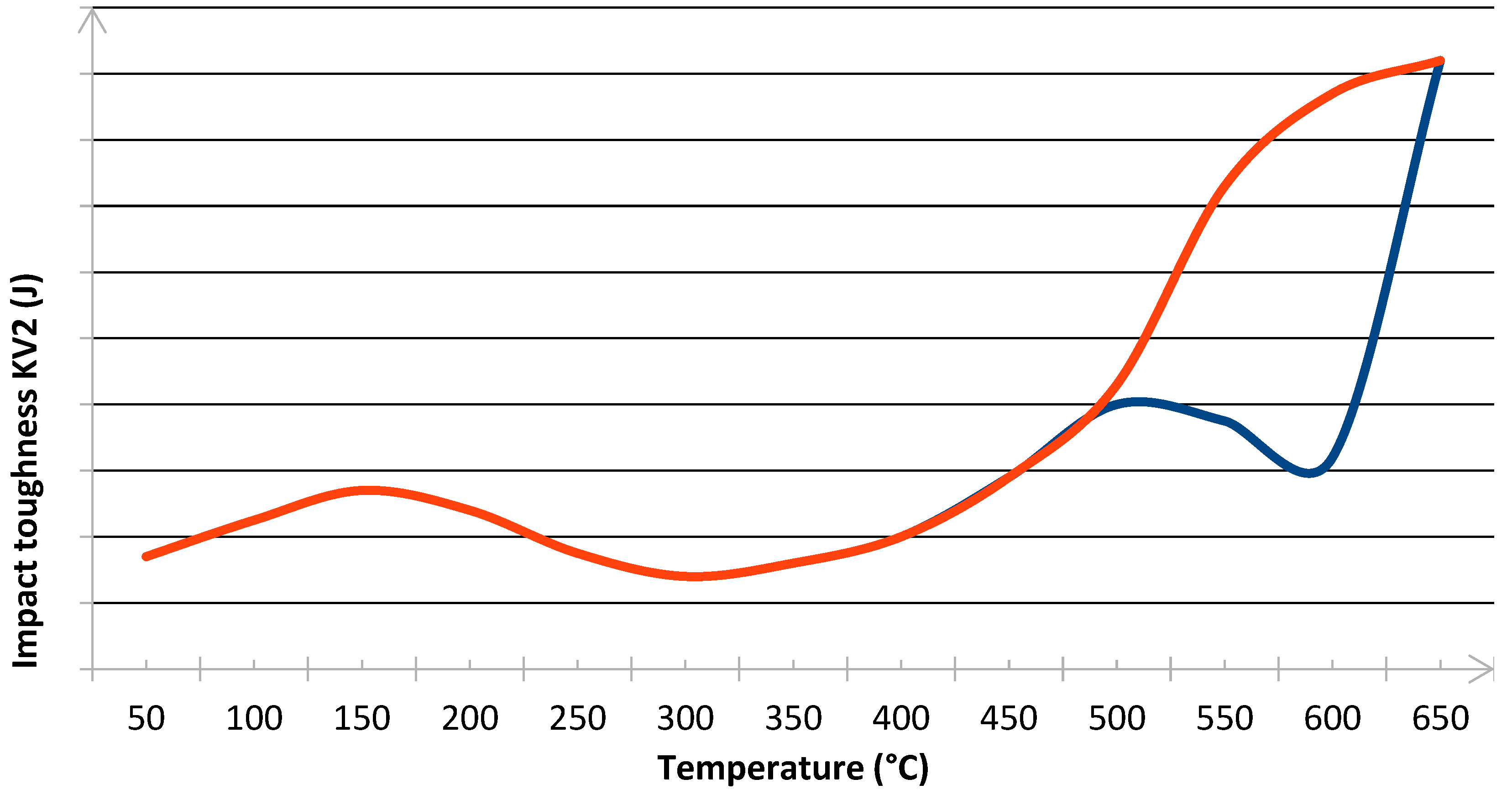

| Element | Sample 1. | Sample 2. | Sample 3. | Sample 4. | Average | Typical |
|---|---|---|---|---|---|---|
| C (%) | 0.33 | 0.33 | 0.33 | 0.33 | 0.33 | 0.3 |
| Si (%) | 0.43 | 0.43 | 0.43 | 0.43 | 0.43 | 0.3 |
| Mn (%) | 1.14 | 1.13 | 1.13 | 1.14 | 1.14 | 1.2 |
| Cr (%) | 2.34 | 2.34 | 2.34 | 2.34 | 2.34 | 2.3 |
| Mo (%) | 0.78 | 0.78 | 0.78 | 0.78 | 0.78 | 0.8 |
| V (%) | 0.83 | 0.81 | 0.82 | 0.81 | 0.82 | 0.8 |
| Ni (%) | 3.88 | 3.88 | 3.88 | 3.88 | 3.88 | 4.0 |
| P (%) | 0.014 | 0.014 | 0.014 | 0.014 | 0.014 | - |
| S (%) | 0.029 | 0.021 | 0.027 | 0.03 | 0.027 | - |
| Al (%) | 0.019 | 0.021 | 0.02 | 0.02 | 0.02 | - |
| Co (%) | 0.019 | 0.019 | 0.02 | 0.02 | 0.02 | - |
| Cu (%) | 0.14 | 0.094 | 0.074 | 0.066 | 0.093 | - |
| W (%) | 0.026 | 0.025 | 0.025 | 0.025 | 0.025 | - |
| Te (%) | 0.021 | 0.021 | 0.021 | 0.021 | 0.021 | - |
| Ta (%) | 0.074 | 0.074 | 0.077 | 0.065 | 0.072 | - |
| B (%) | 0.0007 | 0.0006 | 0.0005 | 0.0007 | 0.0006 | - |
| Fe (%) | 89.8 | 89.9 | 89.9 | 89.9 | 89.9 | Bal. |
| Other (%) | Bal. | - | ||||
| Sample No. | Graph | Fracture Area |
|---|---|---|
| 1 | 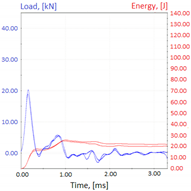 |  |
| 2 |  | |
| 3 | 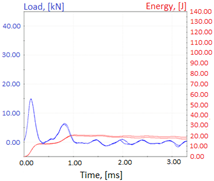 |  |
| 4 |  |
| Sample Number | Sample Width (mm) | Notch Bottom Position (mm) | Maximum Load (kN) | Impact Energy KV2 (J) | Mean Impact Energy KV2avg (J) | Mean Sample Hardness (HRC) | Average Material Hardness (HRC) |
|---|---|---|---|---|---|---|---|
| 1 | 9.97 | 8.00 | 18.94 | 16.3 | 17.0 | 46.5 | 46.4 |
| 2 | 9.96 | 7.99 | 20.25 | 17.7 | 46.4 | ||
| 3 | 9.97 | 8.00 | 14.86 | 12.2 | 12.3 | 46 | |
| 4 | 9.97 | 8.00 | 14.91 | 12.4 | 46.6 |
| Steel Alloy | Standard Hardness (HRC) | Standard Impact Toughness KV (J) | Source |
|---|---|---|---|
| H13 | 46 38–53 | ~26 Very high | [20] [21] |
| 33H3MF | 26 | 92 | [22] |
| Orvar Supreme | 45 | ~16 | [23] |
| WCLV | 56 | 25.6 | [24] |
| 48 | 32 | ||
| 25H2N4WA | 27.6 | 63 | [25] |
| 30HN2MFA | 35.5–41 | 20 | [25] |
| Dievar | 44–46 | 43 | [26] |
| QRO 90 Supreme | 45 | 15 | [27,31] |
| Vidar Superior | 45 | 30 | [28,31] |
| Bohler W300 | 50–52 | 19–28 | [29] |
| Bohler W400 | 50–52 | 26–36 | [30] |
| Element | C (%) | Si (%) | Mn (%) | Cr (%) | Mo (%) | V (%) | Ni (%) | P (%) | S (%) |
|---|---|---|---|---|---|---|---|---|---|
| H13 | 0.32–0.45 | 0.8–1.2 | 0.2–0.5 | 4.75–5.5 | 1.1–1.75 | 0.8–1.2 | 0.3 max | ||
| Orvar Supreme | 0.39 | 1.0 | 0.4 | 5.2 | 1.4 | 0.9 | - | ||
| 33H3MF | 0.29–0.36 | 0.17–0.37 | 0.5–0.8 | 2.4–2.8 | 0.35–0.45 | 0.2–0.3 | 0.3 max | 0.035 max | 0.035 max |
| WCLV | 0.35–0.45 | 0.8–1.2 | 0.2–0.5 | 4.5–5.5 | 1.2–1.5 | 0.8–1.1 | 0.35 max | 0.03 max | 0.03 max |
| 25H2N4WA | 0.21–0.28 | 0.17–0.37 | 0.25–0.55 | 1.35–1.65 | - | - | 4–4.0 | 0.03 max | 0.025 |
| 30HN2MFA | 0.26–0.33 | 0.17–0.37 | 0.3–0.6 | 0.6–0.9 | 0.2–0.3 | 0.15–0.3 | 2–2.5 | 0.03 | 0.03 |
| Dievar | 0.35 | 0.2 | 0.5 | 5 | 2.3 | 0.6 | - | ||
| Bohler W300 | 0.38 | 1.1 | 0.40 | 5 | 1.3 | 0.4 | - | ||
| Bohler W400 | 0.37 | 0.2 | 0.25 | 5 | 1.3 | 0.45 | - | ||
| QRO 90 Supreme | 0.38 | 0.3 | 0.8 | 2.6 | 2.3 | 0.9 | - | ||
| Vidar Superior | 0.36 | 0.3 | 0.3 | 5 | 1.3 | 0.5 | - |
| Sample Number | HT 1. | HT 2. | HT 3. | ST (°C) |
|---|---|---|---|---|
| 1.1, 1.2 | Quenching at 960 °C for 25′ | Tempering at 600 °C for 2 h | Tempering at 580 °C for 2 h | +20 ± 2 |
| 1.3, 1.4 | −29 ± 2 | |||
| 2.1, 2.2 | Quenching at 960 °C for 25′ | Tempering at 200 °C for 2 h | Tempering at 200 °C for 2 h | +20 ± 2 |
| 2.3, 2.4 | −29 ± 2 | |||
| 3.1, 3.2 | Quenching at 1020 °C for 25′ | Tempering at 640 °C for 2 h | Tempering at 600 °C for 2 h | +20 ± 2 |
| 3.3, 3.4 | −29 ± 2 | |||
| 4.1, 4.2 | Tempering at 640 °C for 2 h | Tempering at 600 °C for 2 h | - | +20 ± 2 |
| 4.3, 4.4 | −29 ± 2 |
| Sample Number | Graphs | Fracture Area |
|---|---|---|
| 1.1 |  |  |
| 1.2 |  | |
| 1.3 |  |  |
| 1.4 |  | |
| 2.1 | 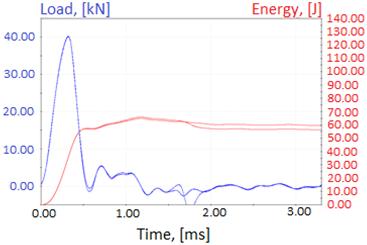 |  |
| 2.2 |  | |
| 2.3 | 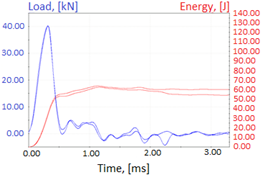 |  |
| 2.4 |  | |
| 3.1 | 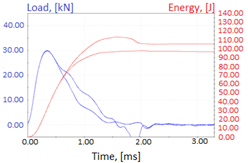 |  |
| 3.2 |  | |
| 3.3 | 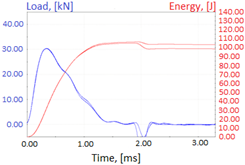 |  |
| 3.4 |  | |
| 4.1 | 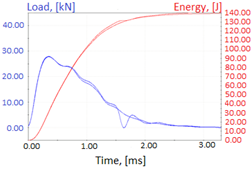 |  |
| 4.2 |  | |
| 4.3 | 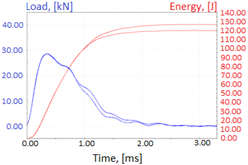 |  |
| 4.4 |  |
| Sample Number | Sample Temp. (°C) | Impact Energy KV2 (J) | Mean Impact Energy KV2avg (J) | Mean Hard. (HRC) | Mean Hard. (HV) | YS (MPa) | TS (MPa) |
|---|---|---|---|---|---|---|---|
| 1.1 | +20 | 126.7 | 123.2 | 36.2 | 356 | 933 | 1101 |
| 1.2 | 119.6 | 35.7 | 351 | 918 | 1084 | ||
| 1.3 | −29 | 112.6 | 107.8 | 37.5 | 369 | 970 | 1145 |
| 1.4 | 103.0 | 36.3 | 357 | 936 | 1104 | ||
| 2.1 | +20 | 57.2 | 57.3 | 48.4 | 489 | 1315 | 1550 |
| 2.2 | 57.4 | 47.8 | 482 | 1295 | 1526 | ||
| 2.3 | −29 | 53.1 | 58.5 | 47.7 | 480 | 1289 | 1519 |
| 2.4 | 63.9 | 48.5 | 491 | 1321 | 1556 | ||
| 3.1 | +20 | 97.7 | 105.4 | 36.2 | 356 | 933 | 1101 |
| 3.2 | 113.1 | 36.1 | 355 | 933 | 1101 | ||
| 3.3 | −29 | 106.4 | 105.7 | 36.1 | 355 | 933 | 1101 |
| 3.4 | 104.9 | 36.9 | 363 | 953 | 1124 | ||
| 4.1 | +20 | 139.2 | 135.4 | 33.5 | 328 | 852 | 1006 |
| 4.2 | 131.6 | 33.6 | 330 | 858 | 1013 | ||
| 4.3 | −29 | 126.6 | 123.2 | 34.1 | 336 | 875 | 1033 |
| 4.4 | 119.8 | 33.7 | 331 | 861 | 1016 |
Publisher’s Note: MDPI stays neutral with regard to jurisdictional claims in published maps and institutional affiliations. |
© 2021 by the authors. Licensee MDPI, Basel, Switzerland. This article is an open access article distributed under the terms and conditions of the Creative Commons Attribution (CC BY) license (https://creativecommons.org/licenses/by/4.0/).
Share and Cite
Mazuro, P.; Pieńkowska, J.; Rostek, E. Influence of Various Heat Treatments on Hardness and Impact Strength of Uddeholm Balder: Cr-Mo-V-Ni Novel Steel Used for Engine Construction. Materials 2021, 14, 4943. https://doi.org/10.3390/ma14174943
Mazuro P, Pieńkowska J, Rostek E. Influence of Various Heat Treatments on Hardness and Impact Strength of Uddeholm Balder: Cr-Mo-V-Ni Novel Steel Used for Engine Construction. Materials. 2021; 14(17):4943. https://doi.org/10.3390/ma14174943
Chicago/Turabian StyleMazuro, Paweł, Julia Pieńkowska, and Ewa Rostek. 2021. "Influence of Various Heat Treatments on Hardness and Impact Strength of Uddeholm Balder: Cr-Mo-V-Ni Novel Steel Used for Engine Construction" Materials 14, no. 17: 4943. https://doi.org/10.3390/ma14174943






